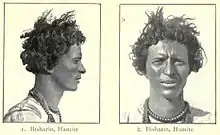Bishari tribe
The Bishari (Arabic: البشارية al-Bishāriyyah or البشاريين al-Bishāriyyīn; Beja: Oobshaari) are an ethnic group inhabiting Northeast Africa. They are one of the major divisions of the Beja people. The Bishari speak the Beja language, which belongs to the Afroasiatic family.
 | |
| Total population | |
|---|---|
| 42,000 | |
| Regions with significant populations | |
| Languages | |
| Beja (Bidhaawyeet), Arabic | |
| Religion | |
| Islam | |
| Related ethnic groups | |
| other Beja |
Demographics
The Bishari live in the eastern part of the Nubian Desert in Sudan and southern Egypt. They reside in the Atabai (also spelled Atbai) area between the Nile River and the Red Sea, north of the Amarar and south of the Ababda- basically between the Nubian desert and the Nile valley, an area of limestone, mountains, with sandstone plateaus.[1]
The Bishari population numbers around 42,000 individuals. Most of the tribe moves within the territory of Sudan, where members have political representation in the Beja Congress.[2]
Language
The Bishari speak the Beja language as a mother tongue. It belongs to the Cushitic branch of the Afroasiatic family.[3]
The Beja inhabiting Sudan also speak Sudanese Arabic as a second language.[3] In 1949, a member of the Bishari tribe stated that when they meet a stranger, they immediately ask "'Are you biggaweijet (=Bišari) or belaeijt (Arab)?'" and continued "‘...We call our language biggawija and it contains many elements of Arabic (belaeijet).'"[4]
Economy
The Bishari are traditionally nomadic people, working in husbandry of camels, sheep, and goats in the Southern part of the Eastern Desert. It's an area that is off the beaten path- largely unexplored. Of the tribes in the area, this tribe lives in the more remote areas.[5] The Bishari and the Bishari Qamhatab, believed to be ancient Bishari, have traded agricultural commodities with other people since ancient times.[5][1][6]
Religion
The Bishari are mostly Sufi Muslim.[2] Al-Maqdisi wrote that the Bishari of his time (tenth century CE) were Christians.[7]
See also
References
- Starky, Janet. "Perceptions of the Ababda and Bisharin in the Atbai". University of Durham. Archived from the original on 10 March 2006. Retrieved 23 November 2016.
- Young, John (2007). The Eastern Front and the Struggle against Marginalization (PDF). Small Arms Survey, Graduate Institute of International Studies, Geneva 2007. ISBN 2-8288-0081-4. Archived from the original (PDF) on 2009-06-17. Retrieved 23 November 2016.
- "Bedawiyet". Ethnologue. Retrieved 22 November 2017.
- Starkey, Janet (June 2001). "Perceptions of the ʿAbabda and Bisharin in the Atbai". Sudan Studies (26): 40.
- "Egypt People". Britannica. Archived from the original on 24 November 2016. Retrieved 23 November 2016.
- Sidebotham, Steven E.; Hense, Martin; Nouwens, Hendrikje M. (2008). The Red Land: The Illustrated Archaeology of Egypt's Eastern Desert. American University in Cairo Press. ISBN 9789774160943. Retrieved 23 November 2016.
- al-Maqdisī, Abū Nasr Muṭahhar (1899–1919). Huart, Charles (ed.). Le Livre de la Creation et de l'Histoire d'Abou Zaid. Paris: Publ. de l'Ecole des Languages Vivantes Sier IV. p. 148.
Further reading
| Wikisource has the text of the 1911 Encyclopædia Britannica article Bishārīn. |